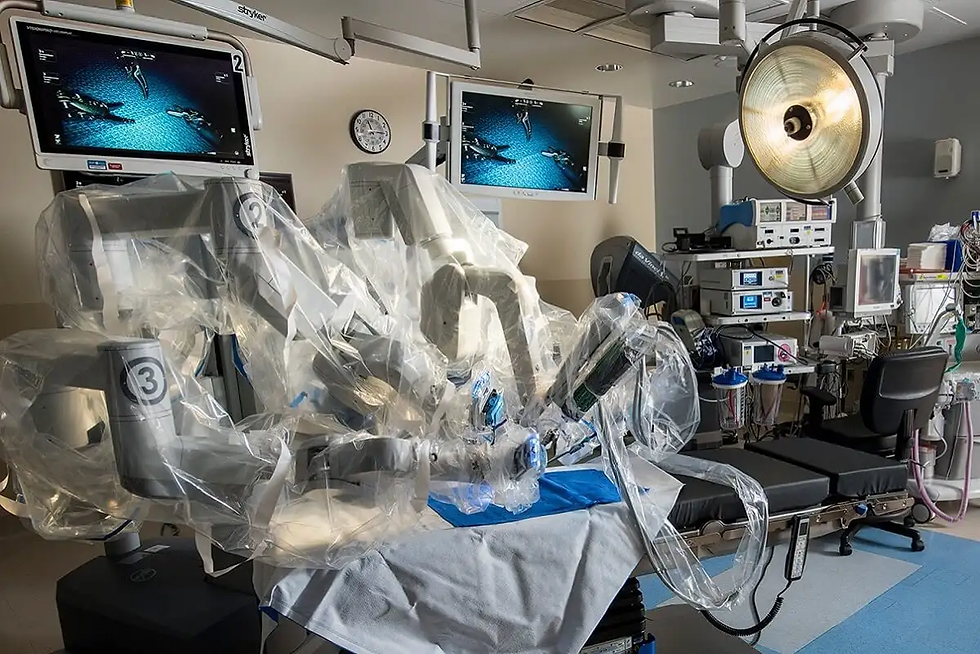By Duru Develioglu
The Lawrenceville School, NJ
The use of robotics in medicine can be beneficial in many ways. Robotic cardiac surgery can be much less invasive than open heart surgery because of its use of precision tools and small cuts during the procedure (Johns Hopkins Medicine, n.d.). Robots in the cardiac field can be utilized in numerous ways whether it’s to remove a tumor, perform a bypass, or repair a valve (Johns Hopkins Medicine, n.d.). It also leaves smaller scars, has a faster healing time, and the pain goes away in a shorter time period (Johns Hopkins Medicine, n.d.).

Image of robotic surgery at a hospital
Robotic Surgeries. (2022, November 16). Trinity Health System. https://www.saintalphonsus.org/blog/blogs/medical-innovations/robotic-surgeries
Another benefit of robotic cardiac surgery is that when making an incision, to open one’s chest, their surgeon won't have to cut into the breastbone, which can result in a shorter healing process (Johns Hopkins Medicine, n.d.). When looking at some statistics of robotic surgery, overall, it has a median cost of $39,030 versus the non-robotic surgery cost of $36,340 (Yanagawa). Observing the mortality rate of robotic surgery, there is a mortality rate of 1% compared to non-robotic surgeries which have a mortality rate of 1.9% (Yanagawa et al., 2015). The complications among all surgeries for robotic surgeries was 27.2% compared to non-robotic surgery complication percentage of 30.3% (Yanagawa et al., 2015).
Lastly, observing the difference between the length of stay at the hospital, robotic surgeries’ average length of stay was 5 days compared to non-robotic surgeries’ average 6 day stay (Yanagawa et al., 2015). The median cost may be higher, but the statistics certainly show the benefits of a slight price increase.

Image of the Da Vinci System to be implemented in hospitals
Da Vinci Surgery - Robotic Surgery - Laparoscopic Surgery - Urology Austin. (2018, August 9). Urology Austin. https://urologyaustin.com/urology-specialties/da-vinci-robotic-surgery/
F. Moll and R. Young made the Da Vinci Robotic System which is commonly used today (Pugin et al., 2011). There are many different parts to this complex robotic system: the surgeon’s console which allows for the transmission of images and a 3D view of the operation field, the patient trolley with a arm equipped with a camera, two to three arms with surgical instruments, and the joystick which allows for the surgeon to have control of their instruments and camera (Pugin et al., 2011) This system allows for freedom of movement without shaking, a range of motion as though the procedure wasn’t being done mechanically, and fitting into tight spaces with small incisions (Modi et al., 2009).
An example of a robotic aided procedure is an endoscopic coronary artery bypass. Endoscopic coronary artery bypass is a type of coronary revascularization surgery and involves the grafting of the left internal thoracic artery onto the left anterior descending artery (Harky & Hussain, 2019). Using a robot to do this will allow the procedure to be much less invasive and over 300 patients have undergone this surgery with a 0.6% mortality rate, and a 2% stroke rate (Harky & Hussain, 2019). Within 5 years after the surgery, 81% say they have had continuous freedom from major adverse reactions (Harky & Hussain, 2019).
Robotics in the field of cardiac surgery is a vital tool in the advancement of cardiac procedures. It provides a safer, less invasive, more efficient way of operating. Using the tools of the future is incredibly crucial not only because of their many benefits, but also because they make the surgery easier for both the doctor and the patient. They are procedure mechanisms and a more reliable way to operate.
-----
Harky, A., & Hussain, S. M. A. (2019). Robotic cardiac surgery: The future gold standard or an unnecessary extravagance? Brazilian Journal of Cardiovascular Surgery, 34(4). https://doi.org/10.21470/1678-9741-2019-0194
Johns Hopkins Medicine. (n.d.). Robotic Cardiac Surgery. Retrieved November 9, 2024, from https://www.hopkinsmedicine.org/health/treatment-tests-and-therapies/robotic-cardiac-surgery
Modi, P., Rodriguez, E., & Chitwood, W. R., Jr. (2009). Robot-assisted cardiac surgery. Interactive CardioVascular and Thoracic Surgery, 9(3), 500-505.https://doi.org/10.1510/icvts.2009.203182
Pugin, F., Bucher, P., & Morel, P. (2011). History of robotic surgery : From aesop® and zeus® to da vinci®. Journal of Visceral Surgery, 148(5), e3-e8. https://doi.org/10.1016/j.jviscsurg.2011.04.007
Yanagawa, F., Perez, M., Bell, T., Grim, R., Martin, J., & Ahuja, V. (2015). Critical outcomes in nonrobotic vs robotic-assisted cardiac surgery. JAMA Surgery, 150(8), 771. https://doi.org/10.1001/jamasurg.2015.1098
%202.png)
Comments